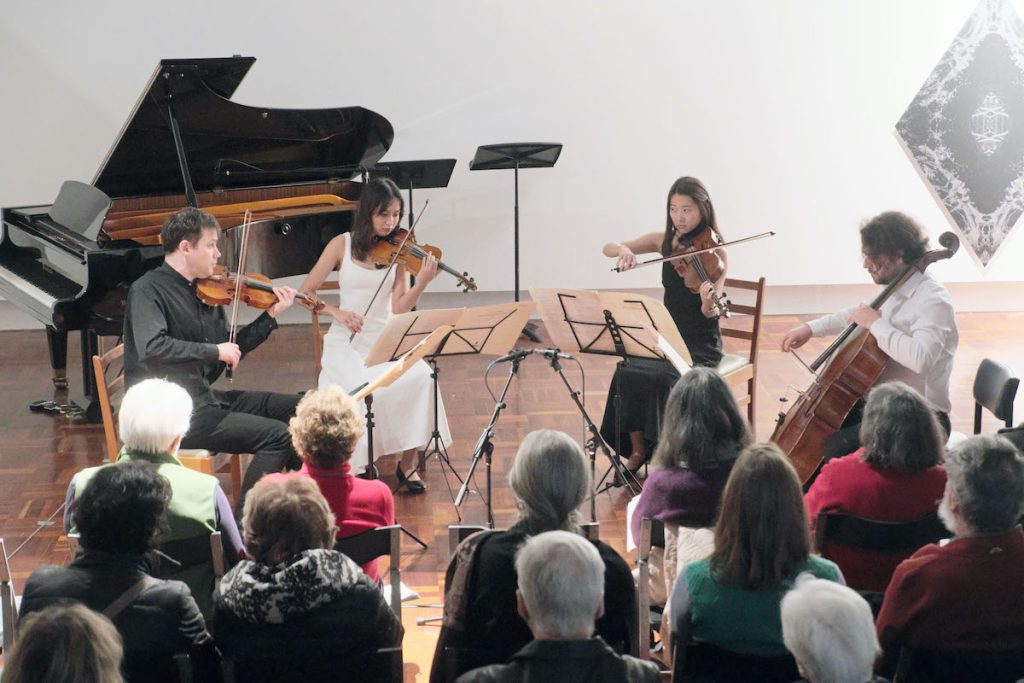ANU’s School of Art and Design Gallery a perfect setting for an exploration of works by György Ligeti, a giant of 20th century music.
György Ligeti, born in 1923, composed some of the most striking music of the 20th century. His sound is rooted in Hungarian folk music. While he didn’t know it, he also wrote the evocative theme to Stanley Kubrick’s 2001: A Space Odyssey. His music was used without his knowledge.
Known for virtuosic, complex and meticulous rhythmic and modal patterns in his music, Ligeti longed to escape from the musical ideas of the past. This concert revealed just some of his extensive musical repertoire.
The performers were Edward Neeman and Aron Ottignon (piano), Donald Nicolson (harpsichord), the Alma Moodie Quartet, Fletcher Cox and Miroslav Bukovsky (trumpets) and saxophonist John Mackey.
Before the concert, composer and ABC The Music Show presenter Andrew Ford gave a talk on Ligeti in the School of Music lecture theatre. While revealing many interesting facts, Ford looked back on Ligeti’s creative output and what it means today.
The ANU School of Art and Design Gallery was the perfect setting for this performance. This atmospheric space was filled with vibrant colours and designs, creating an immersive and complete artistic experience.
The concert celebrating 100 years since Ligeti’s birth began with a work titled The Big Turtle Fanfare from the South China Sea. It’s a flourish for the trumpet. Performed by Fletcher Cox, it took just 40 seconds to complete.
Continuum (1968), played by Donald Nicolson on harpsichord, is a spellbinding work that can transfix a listener. No matter where it is played on the keyboard, it follows a similar rapid rhythmic pattern all the way through.
Notes overlap notes in this work; it creates a wall of sound. While it’s a soft resonance on the harpsichord, the wash of music that rapidly changes key mesmerises. Hearing the jacks rise and fall on the harpsichord is part of the experience.
Next, Three Piano Etudes, (1985), performed by Edward Neeman. It begins where Continuumleft off with hundreds of notes being quickly played. The first of the Etudes is like a wash of colours, all hitting the canvas at once.
Softly and slowly, the mysterious second Etude seems to search for a voice, and maybe a home. Its density thickens as chordal textures take over. They fall back to single notes before chords rise again. Then it slowly drifted to a high soft finish.
More melodic than the others, the third Etude told a compelling story. It rushes, then waits. It falls and cascades. Neeman’s chops are truly remarkable. Each Etude was performed with dexterity and precision.
Ligeti, “Re-mix”, was performed by Bukovsky, Mackey and Ottignon. With sax and trumpet almost mirroring one another, while the piano filled in the chords, this atmospheric music created a cool jazz sound that told another side of Ligeti’s music. The second reharmonisation in a similar setting as the first, softly and sadly played out.

Then the String Quartet No. 2 (1968), performed by the Alma Moodie Quartet – Kristian Winther, violin, Anna da Silva Chen, violin, Dana Lee, viola and Thomas Marlin, cello.
Nervous harmonics fill the first dozen or so bars of this edgy work. Hence the title of the first movement, Allegro nervoso. Taking human emotions, such as furious, calm and cheerful and transcribing them into music, may just be what music is all about. Also, with Ligeti having lived through World War II and the Soviet’s crushing of the Hungarian uprising of 1956, his music seems to represent all the things that conflict and struggle bring.
In five movements, this quartet asks a lot of a performer. The large number of varied bow and finger techniques can test the best player. Balancing this work with its amazingly quick repositioning of dynamics, rhythms, and techniques and then remaining focused is an arduous task. But the Alma Moodie Quartet produced such a combined performance when, even in the most difficult sections, it remained unified and clear.
The Sostenuto, molto calmo, breathes like it’s on edge while waiting for something dangerous to happen. When it happens, it cracks and spits out its sound. The tension never lets up. The pizzicato third movement was a lesson in complex mathematics and an almost inaudible dynamic.
The final two movements, like the others, move into fresh territory. As with all of Ligeti’s music, its originality and constant flux sits at the heart of what he writes. Ligeti’s individuality was so evident in this extraordinary performance.
The final “Re-mix” for the same players as before, brought about a closer version of Ligeti’s sound. A soft repeated line on the piano flowed with the trumpet adding in whistling noises. The saxophone then entered, and the piece developed a jazzier atmosphere. It was experimental yet constructed.
The concert finished with the return of The Big Turtle Fanfare from the South China Sea, but this time, played by Cox behind the audience.
Feature image: Aron Ottignon, John Mackey and Miroslav Bukovsky, Ligeti100, Canberra International Music Festival. Photo © Peter Hislop
This review was originally written and published by ROB KENNEDY from LIMELIGHT on 02 May 2023.
